Audience Engagement: Changes in Contemporary Television Industry
VerifiedAdded on 2023/06/04
|18
|4041
|428
Report
AI Summary
This report examines the evolving landscape of the television industry and the shifting behaviors of audiences, particularly focusing on the impact of PayTV services like Netflix. It explores how globalization and the rise of online media have transformed viewership patterns and audience perceptions. The study aims to integrate media audience engagement into media theory, addressing the gap in previous research. The research objectives include analyzing audience interaction with contemporary television, examining how television formats adapt to technological changes, and evaluating the influence of PayTV on audience engagement. The research methodology employs a pragmatism philosophy, utilizing an experimental method to analyze the relationship between variables, with a focus on data collection, analysis, reliability, validity, sampling, and ethical considerations.
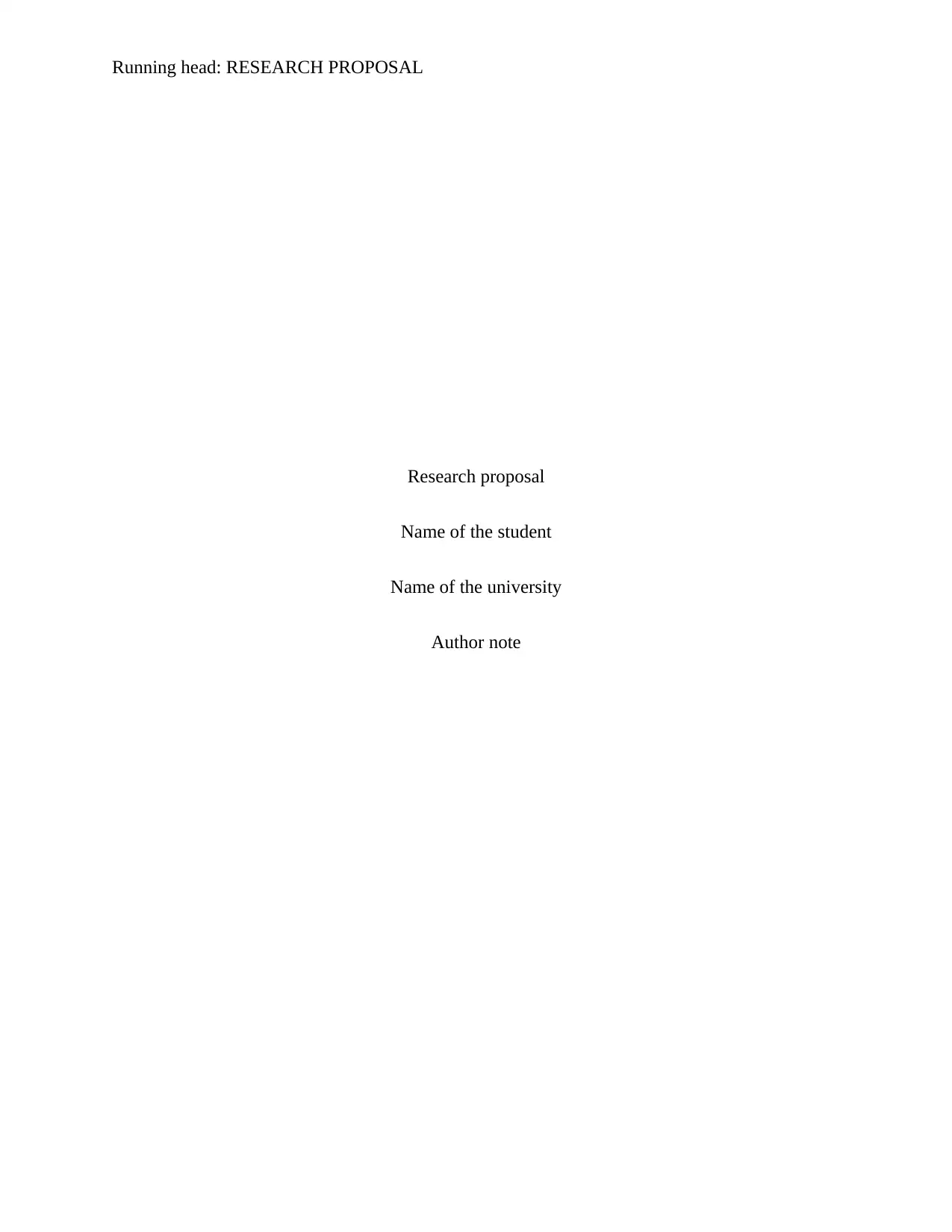
Running head: RESEARCH PROPOSAL
Research proposal
Name of the student
Name of the university
Author note
Research proposal
Name of the student
Name of the university
Author note
Paraphrase This Document
Need a fresh take? Get an instant paraphrase of this document with our AI Paraphraser
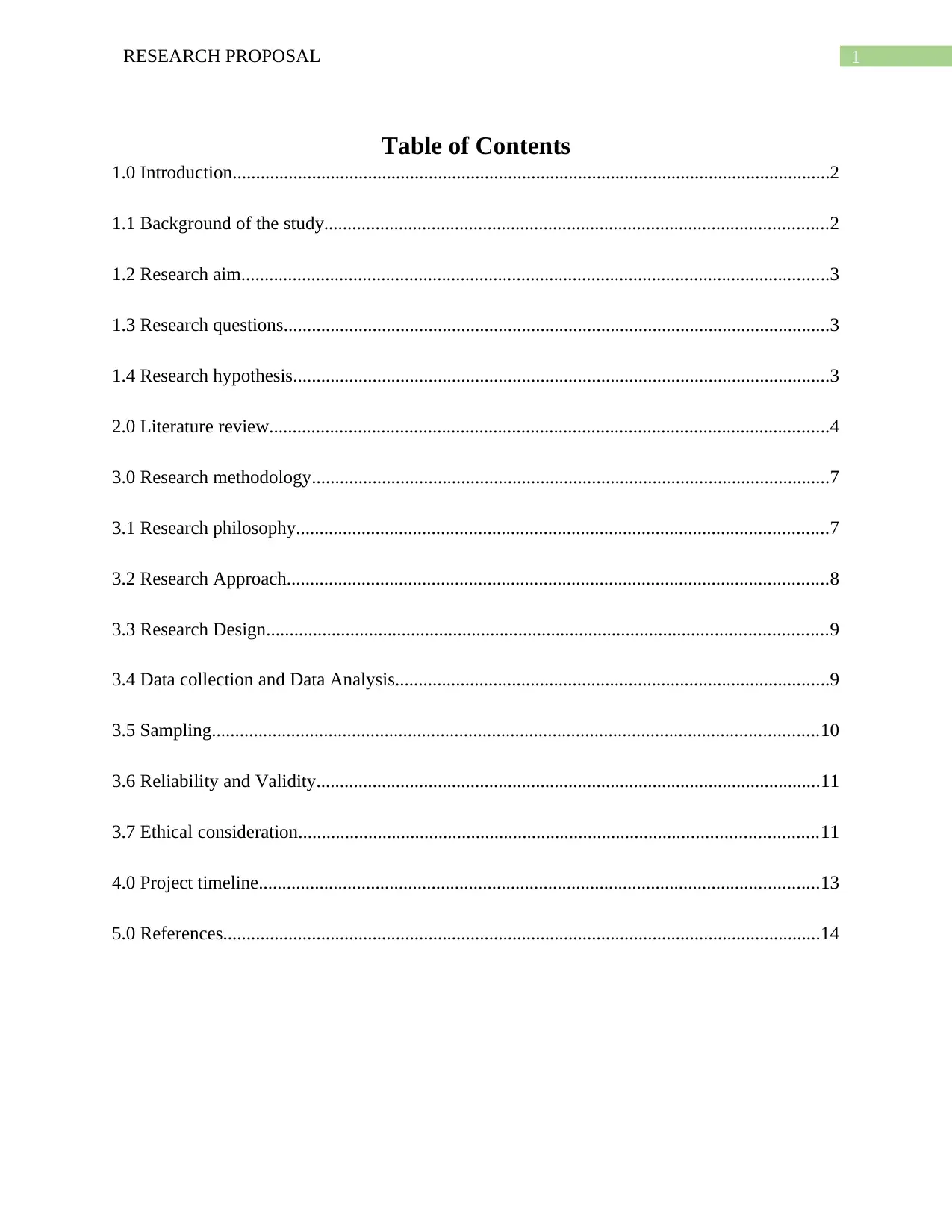
1RESEARCH PROPOSAL
Table of Contents
1.0 Introduction................................................................................................................................2
1.1 Background of the study............................................................................................................2
1.2 Research aim..............................................................................................................................3
1.3 Research questions.....................................................................................................................3
1.4 Research hypothesis...................................................................................................................3
2.0 Literature review........................................................................................................................4
3.0 Research methodology...............................................................................................................7
3.1 Research philosophy..................................................................................................................7
3.2 Research Approach....................................................................................................................8
3.3 Research Design........................................................................................................................9
3.4 Data collection and Data Analysis.............................................................................................9
3.5 Sampling..................................................................................................................................10
3.6 Reliability and Validity............................................................................................................11
3.7 Ethical consideration...............................................................................................................11
4.0 Project timeline........................................................................................................................13
5.0 References................................................................................................................................14
Table of Contents
1.0 Introduction................................................................................................................................2
1.1 Background of the study............................................................................................................2
1.2 Research aim..............................................................................................................................3
1.3 Research questions.....................................................................................................................3
1.4 Research hypothesis...................................................................................................................3
2.0 Literature review........................................................................................................................4
3.0 Research methodology...............................................................................................................7
3.1 Research philosophy..................................................................................................................7
3.2 Research Approach....................................................................................................................8
3.3 Research Design........................................................................................................................9
3.4 Data collection and Data Analysis.............................................................................................9
3.5 Sampling..................................................................................................................................10
3.6 Reliability and Validity............................................................................................................11
3.7 Ethical consideration...............................................................................................................11
4.0 Project timeline........................................................................................................................13
5.0 References................................................................................................................................14
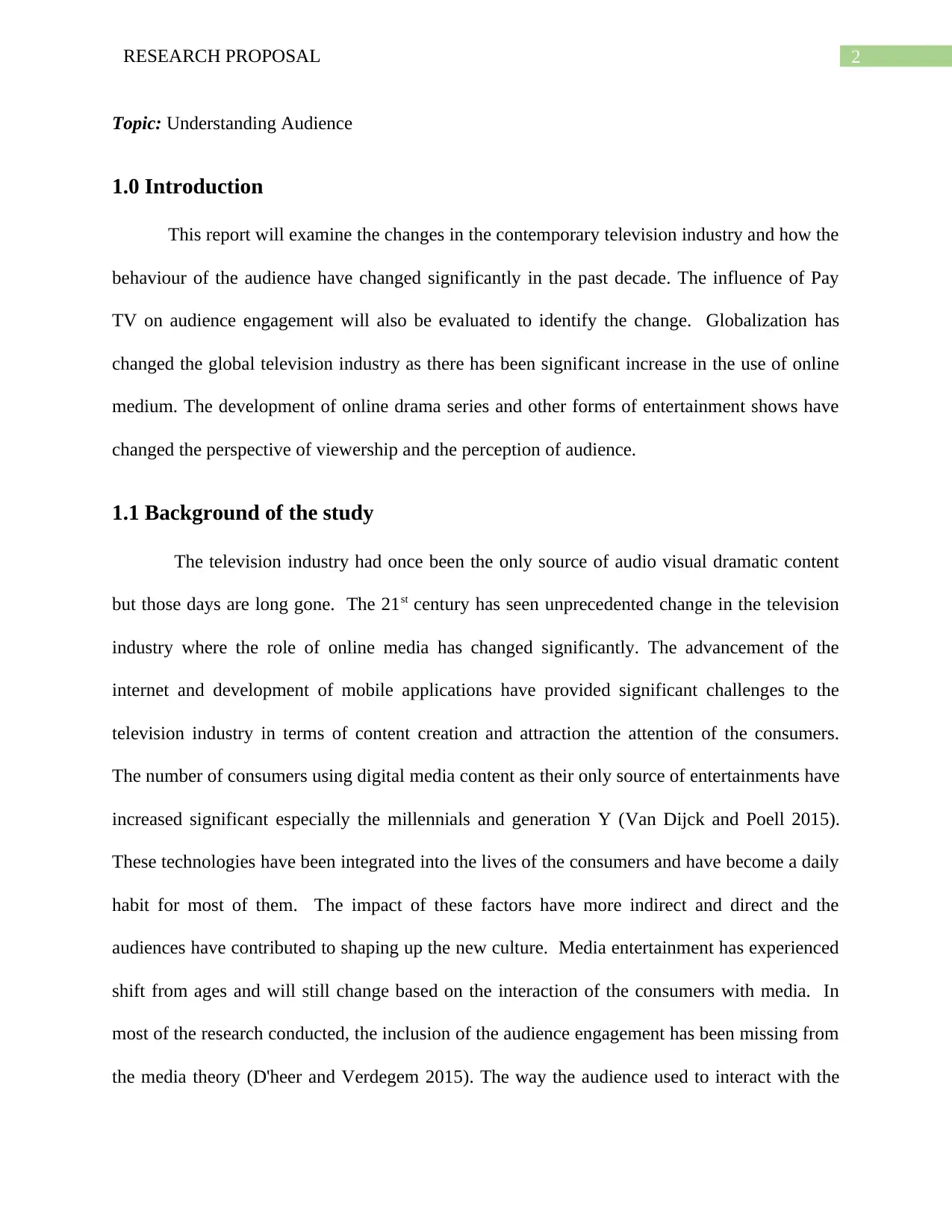
2RESEARCH PROPOSAL
Topic: Understanding Audience
1.0 Introduction
This report will examine the changes in the contemporary television industry and how the
behaviour of the audience have changed significantly in the past decade. The influence of Pay
TV on audience engagement will also be evaluated to identify the change. Globalization has
changed the global television industry as there has been significant increase in the use of online
medium. The development of online drama series and other forms of entertainment shows have
changed the perspective of viewership and the perception of audience.
1.1 Background of the study
The television industry had once been the only source of audio visual dramatic content
but those days are long gone. The 21st century has seen unprecedented change in the television
industry where the role of online media has changed significantly. The advancement of the
internet and development of mobile applications have provided significant challenges to the
television industry in terms of content creation and attraction the attention of the consumers.
The number of consumers using digital media content as their only source of entertainments have
increased significant especially the millennials and generation Y (Van Dijck and Poell 2015).
These technologies have been integrated into the lives of the consumers and have become a daily
habit for most of them. The impact of these factors have more indirect and direct and the
audiences have contributed to shaping up the new culture. Media entertainment has experienced
shift from ages and will still change based on the interaction of the consumers with media. In
most of the research conducted, the inclusion of the audience engagement has been missing from
the media theory (D'heer and Verdegem 2015). The way the audience used to interact with the
Topic: Understanding Audience
1.0 Introduction
This report will examine the changes in the contemporary television industry and how the
behaviour of the audience have changed significantly in the past decade. The influence of Pay
TV on audience engagement will also be evaluated to identify the change. Globalization has
changed the global television industry as there has been significant increase in the use of online
medium. The development of online drama series and other forms of entertainment shows have
changed the perspective of viewership and the perception of audience.
1.1 Background of the study
The television industry had once been the only source of audio visual dramatic content
but those days are long gone. The 21st century has seen unprecedented change in the television
industry where the role of online media has changed significantly. The advancement of the
internet and development of mobile applications have provided significant challenges to the
television industry in terms of content creation and attraction the attention of the consumers.
The number of consumers using digital media content as their only source of entertainments have
increased significant especially the millennials and generation Y (Van Dijck and Poell 2015).
These technologies have been integrated into the lives of the consumers and have become a daily
habit for most of them. The impact of these factors have more indirect and direct and the
audiences have contributed to shaping up the new culture. Media entertainment has experienced
shift from ages and will still change based on the interaction of the consumers with media. In
most of the research conducted, the inclusion of the audience engagement has been missing from
the media theory (D'heer and Verdegem 2015). The way the audience used to interact with the
⊘ This is a preview!⊘
Do you want full access?
Subscribe today to unlock all pages.

Trusted by 1+ million students worldwide
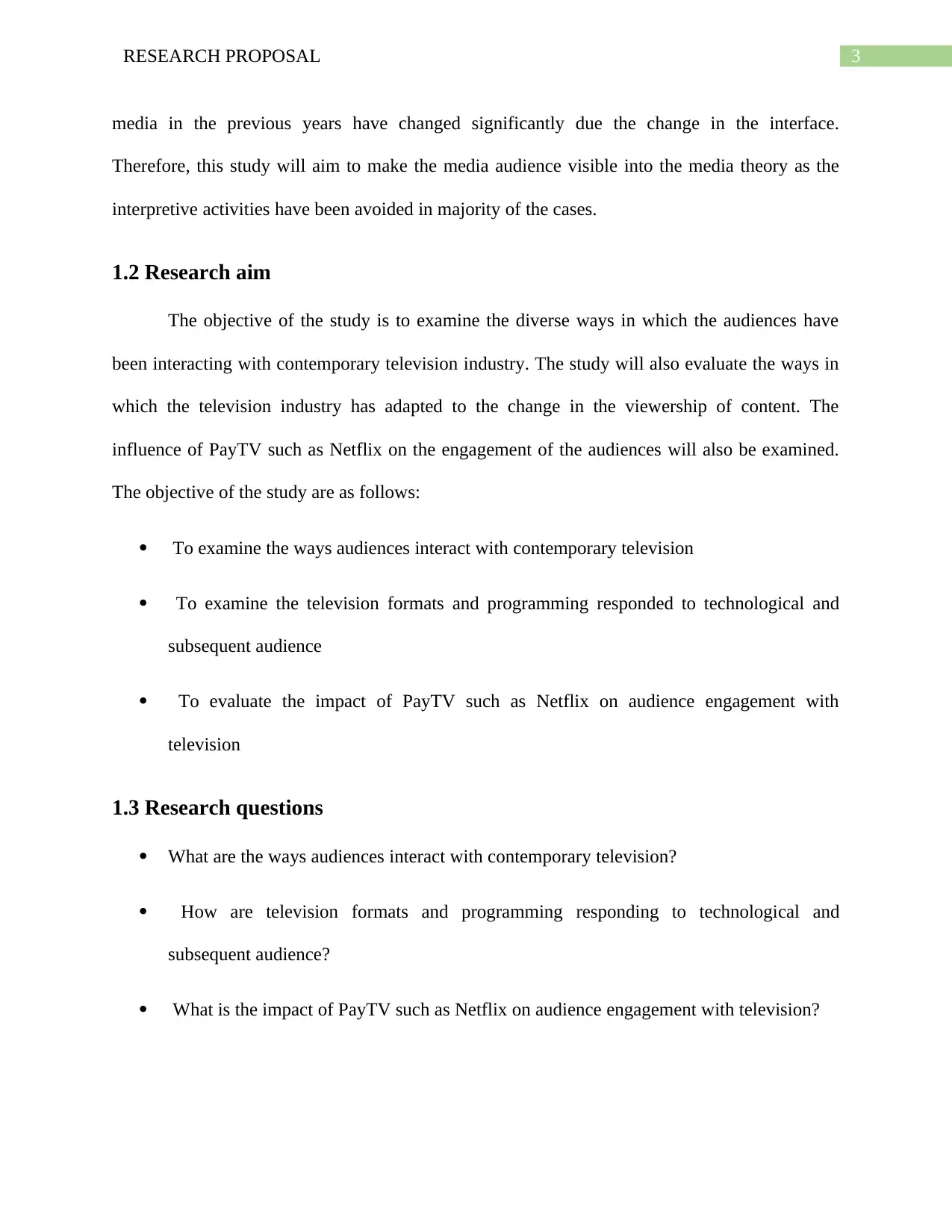
3RESEARCH PROPOSAL
media in the previous years have changed significantly due the change in the interface.
Therefore, this study will aim to make the media audience visible into the media theory as the
interpretive activities have been avoided in majority of the cases.
1.2 Research aim
The objective of the study is to examine the diverse ways in which the audiences have
been interacting with contemporary television industry. The study will also evaluate the ways in
which the television industry has adapted to the change in the viewership of content. The
influence of PayTV such as Netflix on the engagement of the audiences will also be examined.
The objective of the study are as follows:
To examine the ways audiences interact with contemporary television
To examine the television formats and programming responded to technological and
subsequent audience
To evaluate the impact of PayTV such as Netflix on audience engagement with
television
1.3 Research questions
What are the ways audiences interact with contemporary television?
How are television formats and programming responding to technological and
subsequent audience?
What is the impact of PayTV such as Netflix on audience engagement with television?
media in the previous years have changed significantly due the change in the interface.
Therefore, this study will aim to make the media audience visible into the media theory as the
interpretive activities have been avoided in majority of the cases.
1.2 Research aim
The objective of the study is to examine the diverse ways in which the audiences have
been interacting with contemporary television industry. The study will also evaluate the ways in
which the television industry has adapted to the change in the viewership of content. The
influence of PayTV such as Netflix on the engagement of the audiences will also be examined.
The objective of the study are as follows:
To examine the ways audiences interact with contemporary television
To examine the television formats and programming responded to technological and
subsequent audience
To evaluate the impact of PayTV such as Netflix on audience engagement with
television
1.3 Research questions
What are the ways audiences interact with contemporary television?
How are television formats and programming responding to technological and
subsequent audience?
What is the impact of PayTV such as Netflix on audience engagement with television?
Paraphrase This Document
Need a fresh take? Get an instant paraphrase of this document with our AI Paraphraser
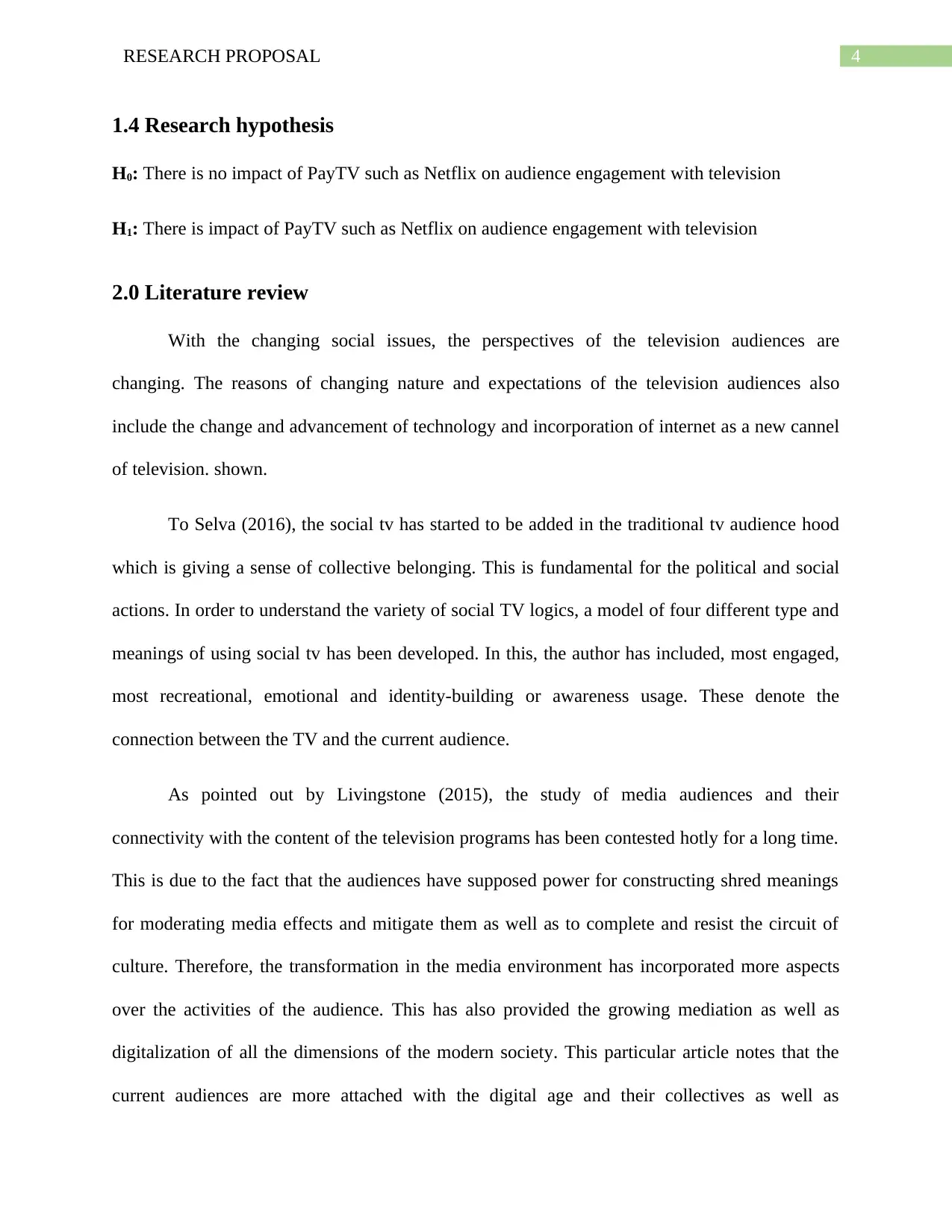
4RESEARCH PROPOSAL
1.4 Research hypothesis
H0: There is no impact of PayTV such as Netflix on audience engagement with television
H1: There is impact of PayTV such as Netflix on audience engagement with television
2.0 Literature review
With the changing social issues, the perspectives of the television audiences are
changing. The reasons of changing nature and expectations of the television audiences also
include the change and advancement of technology and incorporation of internet as a new cannel
of television. shown.
To Selva (2016), the social tv has started to be added in the traditional tv audience hood
which is giving a sense of collective belonging. This is fundamental for the political and social
actions. In order to understand the variety of social TV logics, a model of four different type and
meanings of using social tv has been developed. In this, the author has included, most engaged,
most recreational, emotional and identity-building or awareness usage. These denote the
connection between the TV and the current audience.
As pointed out by Livingstone (2015), the study of media audiences and their
connectivity with the content of the television programs has been contested hotly for a long time.
This is due to the fact that the audiences have supposed power for constructing shred meanings
for moderating media effects and mitigate them as well as to complete and resist the circuit of
culture. Therefore, the transformation in the media environment has incorporated more aspects
over the activities of the audience. This has also provided the growing mediation as well as
digitalization of all the dimensions of the modern society. This particular article notes that the
current audiences are more attached with the digital age and their collectives as well as
1.4 Research hypothesis
H0: There is no impact of PayTV such as Netflix on audience engagement with television
H1: There is impact of PayTV such as Netflix on audience engagement with television
2.0 Literature review
With the changing social issues, the perspectives of the television audiences are
changing. The reasons of changing nature and expectations of the television audiences also
include the change and advancement of technology and incorporation of internet as a new cannel
of television. shown.
To Selva (2016), the social tv has started to be added in the traditional tv audience hood
which is giving a sense of collective belonging. This is fundamental for the political and social
actions. In order to understand the variety of social TV logics, a model of four different type and
meanings of using social tv has been developed. In this, the author has included, most engaged,
most recreational, emotional and identity-building or awareness usage. These denote the
connection between the TV and the current audience.
As pointed out by Livingstone (2015), the study of media audiences and their
connectivity with the content of the television programs has been contested hotly for a long time.
This is due to the fact that the audiences have supposed power for constructing shred meanings
for moderating media effects and mitigate them as well as to complete and resist the circuit of
culture. Therefore, the transformation in the media environment has incorporated more aspects
over the activities of the audience. This has also provided the growing mediation as well as
digitalization of all the dimensions of the modern society. This particular article notes that the
current audiences are more attached with the digital age and their collectives as well as
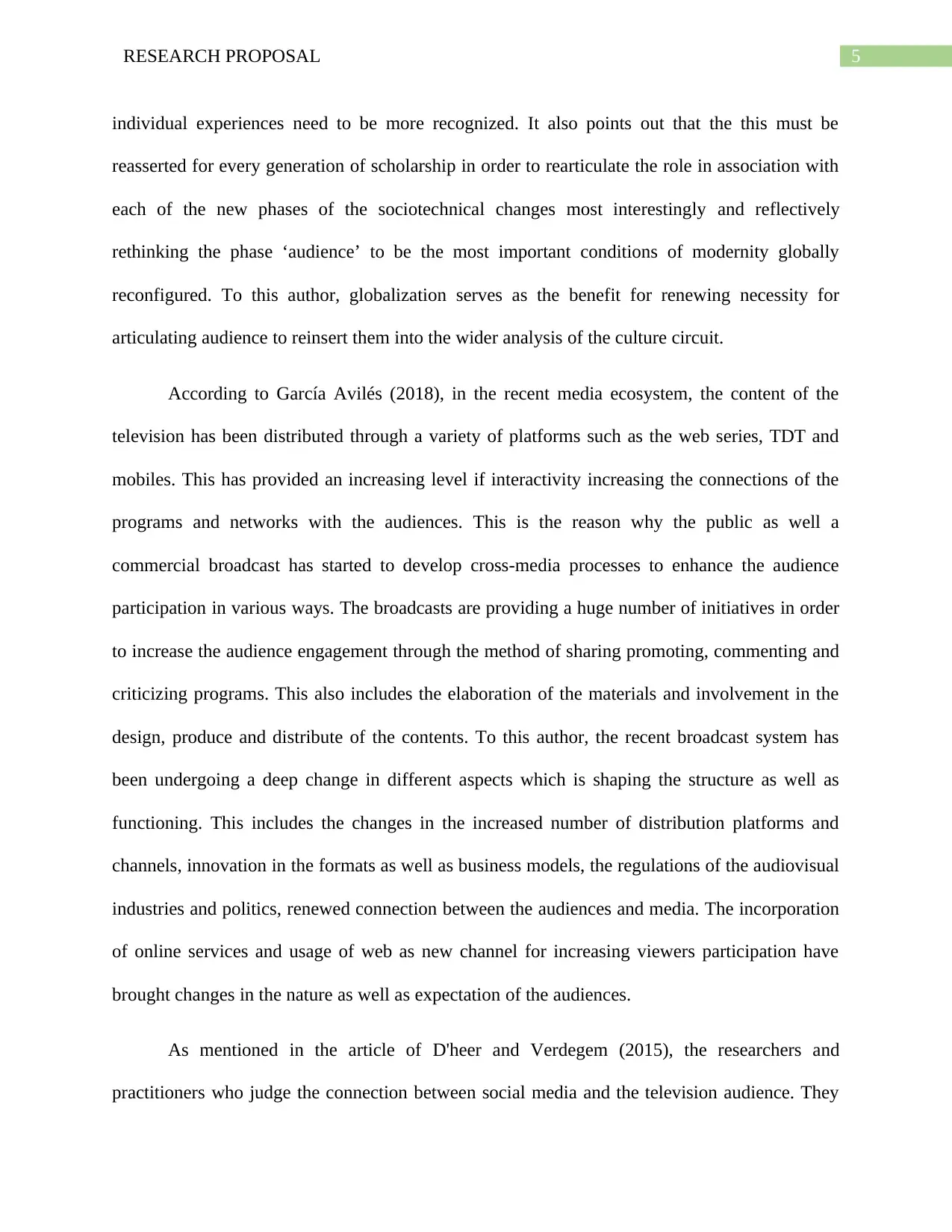
5RESEARCH PROPOSAL
individual experiences need to be more recognized. It also points out that the this must be
reasserted for every generation of scholarship in order to rearticulate the role in association with
each of the new phases of the sociotechnical changes most interestingly and reflectively
rethinking the phase ‘audience’ to be the most important conditions of modernity globally
reconfigured. To this author, globalization serves as the benefit for renewing necessity for
articulating audience to reinsert them into the wider analysis of the culture circuit.
According to García Avilés (2018), in the recent media ecosystem, the content of the
television has been distributed through a variety of platforms such as the web series, TDT and
mobiles. This has provided an increasing level if interactivity increasing the connections of the
programs and networks with the audiences. This is the reason why the public as well a
commercial broadcast has started to develop cross-media processes to enhance the audience
participation in various ways. The broadcasts are providing a huge number of initiatives in order
to increase the audience engagement through the method of sharing promoting, commenting and
criticizing programs. This also includes the elaboration of the materials and involvement in the
design, produce and distribute of the contents. To this author, the recent broadcast system has
been undergoing a deep change in different aspects which is shaping the structure as well as
functioning. This includes the changes in the increased number of distribution platforms and
channels, innovation in the formats as well as business models, the regulations of the audiovisual
industries and politics, renewed connection between the audiences and media. The incorporation
of online services and usage of web as new channel for increasing viewers participation have
brought changes in the nature as well as expectation of the audiences.
As mentioned in the article of D'heer and Verdegem (2015), the researchers and
practitioners who judge the connection between social media and the television audience. They
individual experiences need to be more recognized. It also points out that the this must be
reasserted for every generation of scholarship in order to rearticulate the role in association with
each of the new phases of the sociotechnical changes most interestingly and reflectively
rethinking the phase ‘audience’ to be the most important conditions of modernity globally
reconfigured. To this author, globalization serves as the benefit for renewing necessity for
articulating audience to reinsert them into the wider analysis of the culture circuit.
According to García Avilés (2018), in the recent media ecosystem, the content of the
television has been distributed through a variety of platforms such as the web series, TDT and
mobiles. This has provided an increasing level if interactivity increasing the connections of the
programs and networks with the audiences. This is the reason why the public as well a
commercial broadcast has started to develop cross-media processes to enhance the audience
participation in various ways. The broadcasts are providing a huge number of initiatives in order
to increase the audience engagement through the method of sharing promoting, commenting and
criticizing programs. This also includes the elaboration of the materials and involvement in the
design, produce and distribute of the contents. To this author, the recent broadcast system has
been undergoing a deep change in different aspects which is shaping the structure as well as
functioning. This includes the changes in the increased number of distribution platforms and
channels, innovation in the formats as well as business models, the regulations of the audiovisual
industries and politics, renewed connection between the audiences and media. The incorporation
of online services and usage of web as new channel for increasing viewers participation have
brought changes in the nature as well as expectation of the audiences.
As mentioned in the article of D'heer and Verdegem (2015), the researchers and
practitioners who judge the connection between social media and the television audience. They
⊘ This is a preview!⊘
Do you want full access?
Subscribe today to unlock all pages.

Trusted by 1+ million students worldwide
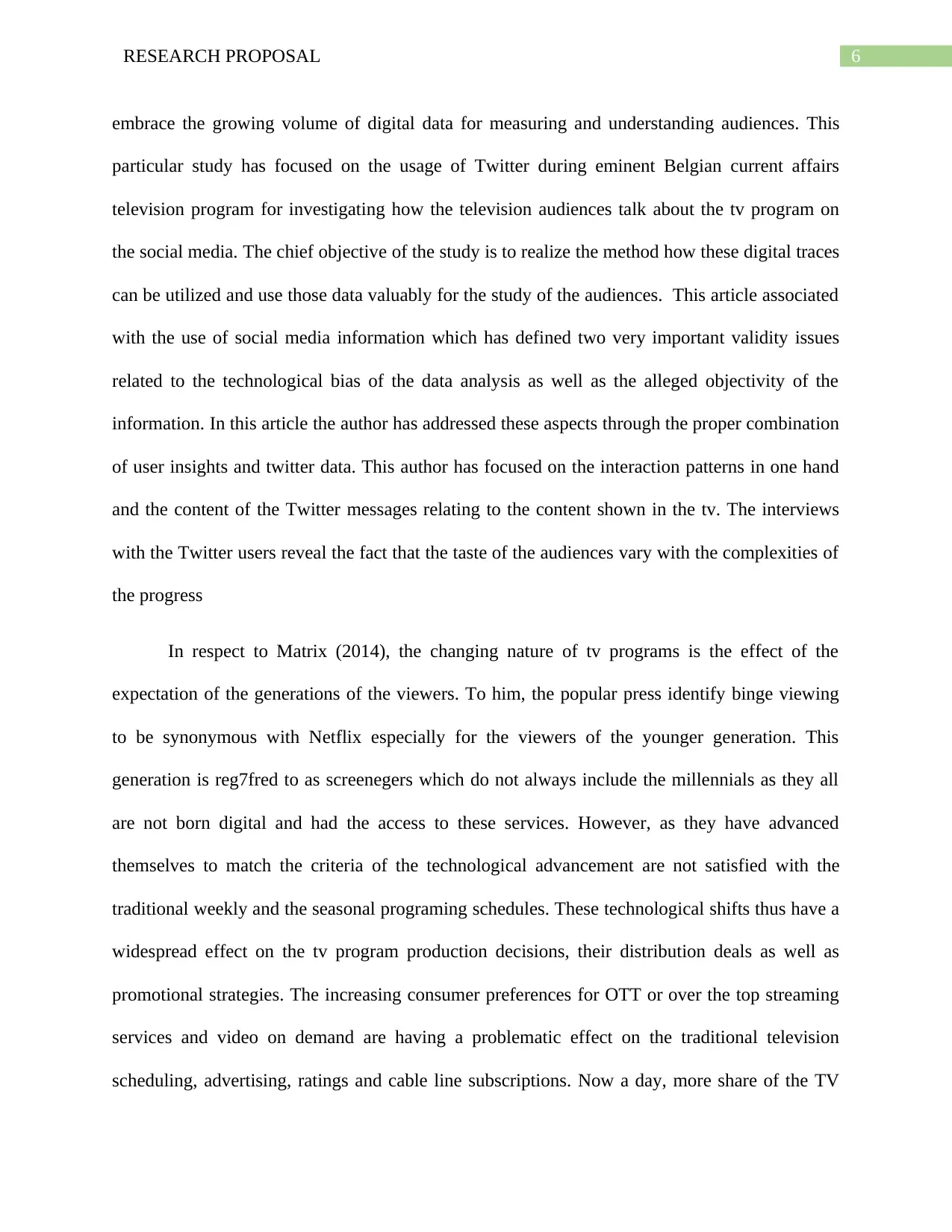
6RESEARCH PROPOSAL
embrace the growing volume of digital data for measuring and understanding audiences. This
particular study has focused on the usage of Twitter during eminent Belgian current affairs
television program for investigating how the television audiences talk about the tv program on
the social media. The chief objective of the study is to realize the method how these digital traces
can be utilized and use those data valuably for the study of the audiences. This article associated
with the use of social media information which has defined two very important validity issues
related to the technological bias of the data analysis as well as the alleged objectivity of the
information. In this article the author has addressed these aspects through the proper combination
of user insights and twitter data. This author has focused on the interaction patterns in one hand
and the content of the Twitter messages relating to the content shown in the tv. The interviews
with the Twitter users reveal the fact that the taste of the audiences vary with the complexities of
the progress
In respect to Matrix (2014), the changing nature of tv programs is the effect of the
expectation of the generations of the viewers. To him, the popular press identify binge viewing
to be synonymous with Netflix especially for the viewers of the younger generation. This
generation is reg7fred to as screenegers which do not always include the millennials as they all
are not born digital and had the access to these services. However, as they have advanced
themselves to match the criteria of the technological advancement are not satisfied with the
traditional weekly and the seasonal programing schedules. These technological shifts thus have a
widespread effect on the tv program production decisions, their distribution deals as well as
promotional strategies. The increasing consumer preferences for OTT or over the top streaming
services and video on demand are having a problematic effect on the traditional television
scheduling, advertising, ratings and cable line subscriptions. Now a day, more share of the TV
embrace the growing volume of digital data for measuring and understanding audiences. This
particular study has focused on the usage of Twitter during eminent Belgian current affairs
television program for investigating how the television audiences talk about the tv program on
the social media. The chief objective of the study is to realize the method how these digital traces
can be utilized and use those data valuably for the study of the audiences. This article associated
with the use of social media information which has defined two very important validity issues
related to the technological bias of the data analysis as well as the alleged objectivity of the
information. In this article the author has addressed these aspects through the proper combination
of user insights and twitter data. This author has focused on the interaction patterns in one hand
and the content of the Twitter messages relating to the content shown in the tv. The interviews
with the Twitter users reveal the fact that the taste of the audiences vary with the complexities of
the progress
In respect to Matrix (2014), the changing nature of tv programs is the effect of the
expectation of the generations of the viewers. To him, the popular press identify binge viewing
to be synonymous with Netflix especially for the viewers of the younger generation. This
generation is reg7fred to as screenegers which do not always include the millennials as they all
are not born digital and had the access to these services. However, as they have advanced
themselves to match the criteria of the technological advancement are not satisfied with the
traditional weekly and the seasonal programing schedules. These technological shifts thus have a
widespread effect on the tv program production decisions, their distribution deals as well as
promotional strategies. The increasing consumer preferences for OTT or over the top streaming
services and video on demand are having a problematic effect on the traditional television
scheduling, advertising, ratings and cable line subscriptions. Now a day, more share of the TV
Paraphrase This Document
Need a fresh take? Get an instant paraphrase of this document with our AI Paraphraser
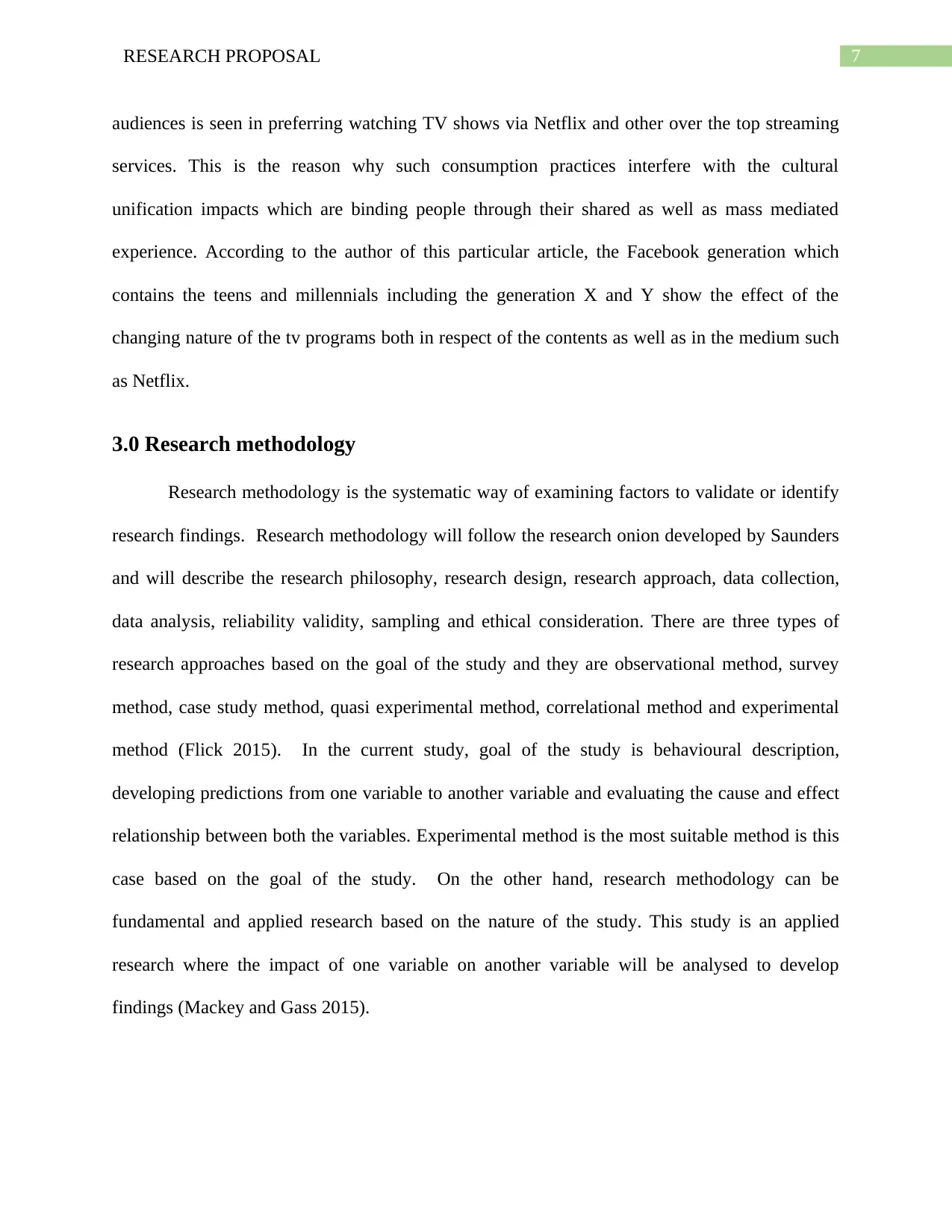
7RESEARCH PROPOSAL
audiences is seen in preferring watching TV shows via Netflix and other over the top streaming
services. This is the reason why such consumption practices interfere with the cultural
unification impacts which are binding people through their shared as well as mass mediated
experience. According to the author of this particular article, the Facebook generation which
contains the teens and millennials including the generation X and Y show the effect of the
changing nature of the tv programs both in respect of the contents as well as in the medium such
as Netflix.
3.0 Research methodology
Research methodology is the systematic way of examining factors to validate or identify
research findings. Research methodology will follow the research onion developed by Saunders
and will describe the research philosophy, research design, research approach, data collection,
data analysis, reliability validity, sampling and ethical consideration. There are three types of
research approaches based on the goal of the study and they are observational method, survey
method, case study method, quasi experimental method, correlational method and experimental
method (Flick 2015). In the current study, goal of the study is behavioural description,
developing predictions from one variable to another variable and evaluating the cause and effect
relationship between both the variables. Experimental method is the most suitable method is this
case based on the goal of the study. On the other hand, research methodology can be
fundamental and applied research based on the nature of the study. This study is an applied
research where the impact of one variable on another variable will be analysed to develop
findings (Mackey and Gass 2015).
audiences is seen in preferring watching TV shows via Netflix and other over the top streaming
services. This is the reason why such consumption practices interfere with the cultural
unification impacts which are binding people through their shared as well as mass mediated
experience. According to the author of this particular article, the Facebook generation which
contains the teens and millennials including the generation X and Y show the effect of the
changing nature of the tv programs both in respect of the contents as well as in the medium such
as Netflix.
3.0 Research methodology
Research methodology is the systematic way of examining factors to validate or identify
research findings. Research methodology will follow the research onion developed by Saunders
and will describe the research philosophy, research design, research approach, data collection,
data analysis, reliability validity, sampling and ethical consideration. There are three types of
research approaches based on the goal of the study and they are observational method, survey
method, case study method, quasi experimental method, correlational method and experimental
method (Flick 2015). In the current study, goal of the study is behavioural description,
developing predictions from one variable to another variable and evaluating the cause and effect
relationship between both the variables. Experimental method is the most suitable method is this
case based on the goal of the study. On the other hand, research methodology can be
fundamental and applied research based on the nature of the study. This study is an applied
research where the impact of one variable on another variable will be analysed to develop
findings (Mackey and Gass 2015).
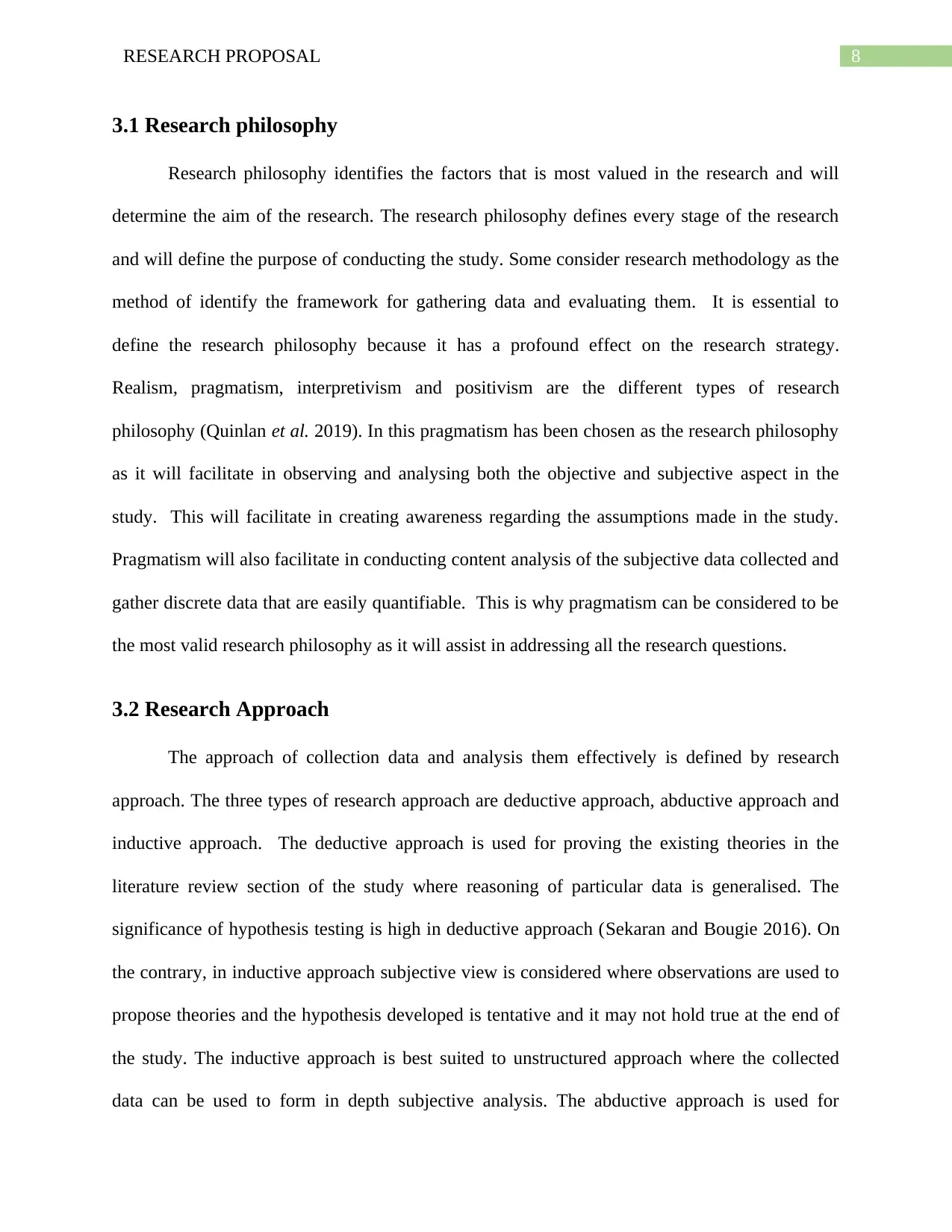
8RESEARCH PROPOSAL
3.1 Research philosophy
Research philosophy identifies the factors that is most valued in the research and will
determine the aim of the research. The research philosophy defines every stage of the research
and will define the purpose of conducting the study. Some consider research methodology as the
method of identify the framework for gathering data and evaluating them. It is essential to
define the research philosophy because it has a profound effect on the research strategy.
Realism, pragmatism, interpretivism and positivism are the different types of research
philosophy (Quinlan et al. 2019). In this pragmatism has been chosen as the research philosophy
as it will facilitate in observing and analysing both the objective and subjective aspect in the
study. This will facilitate in creating awareness regarding the assumptions made in the study.
Pragmatism will also facilitate in conducting content analysis of the subjective data collected and
gather discrete data that are easily quantifiable. This is why pragmatism can be considered to be
the most valid research philosophy as it will assist in addressing all the research questions.
3.2 Research Approach
The approach of collection data and analysis them effectively is defined by research
approach. The three types of research approach are deductive approach, abductive approach and
inductive approach. The deductive approach is used for proving the existing theories in the
literature review section of the study where reasoning of particular data is generalised. The
significance of hypothesis testing is high in deductive approach (Sekaran and Bougie 2016). On
the contrary, in inductive approach subjective view is considered where observations are used to
propose theories and the hypothesis developed is tentative and it may not hold true at the end of
the study. The inductive approach is best suited to unstructured approach where the collected
data can be used to form in depth subjective analysis. The abductive approach is used for
3.1 Research philosophy
Research philosophy identifies the factors that is most valued in the research and will
determine the aim of the research. The research philosophy defines every stage of the research
and will define the purpose of conducting the study. Some consider research methodology as the
method of identify the framework for gathering data and evaluating them. It is essential to
define the research philosophy because it has a profound effect on the research strategy.
Realism, pragmatism, interpretivism and positivism are the different types of research
philosophy (Quinlan et al. 2019). In this pragmatism has been chosen as the research philosophy
as it will facilitate in observing and analysing both the objective and subjective aspect in the
study. This will facilitate in creating awareness regarding the assumptions made in the study.
Pragmatism will also facilitate in conducting content analysis of the subjective data collected and
gather discrete data that are easily quantifiable. This is why pragmatism can be considered to be
the most valid research philosophy as it will assist in addressing all the research questions.
3.2 Research Approach
The approach of collection data and analysis them effectively is defined by research
approach. The three types of research approach are deductive approach, abductive approach and
inductive approach. The deductive approach is used for proving the existing theories in the
literature review section of the study where reasoning of particular data is generalised. The
significance of hypothesis testing is high in deductive approach (Sekaran and Bougie 2016). On
the contrary, in inductive approach subjective view is considered where observations are used to
propose theories and the hypothesis developed is tentative and it may not hold true at the end of
the study. The inductive approach is best suited to unstructured approach where the collected
data can be used to form in depth subjective analysis. The abductive approach is used for
⊘ This is a preview!⊘
Do you want full access?
Subscribe today to unlock all pages.

Trusted by 1+ million students worldwide
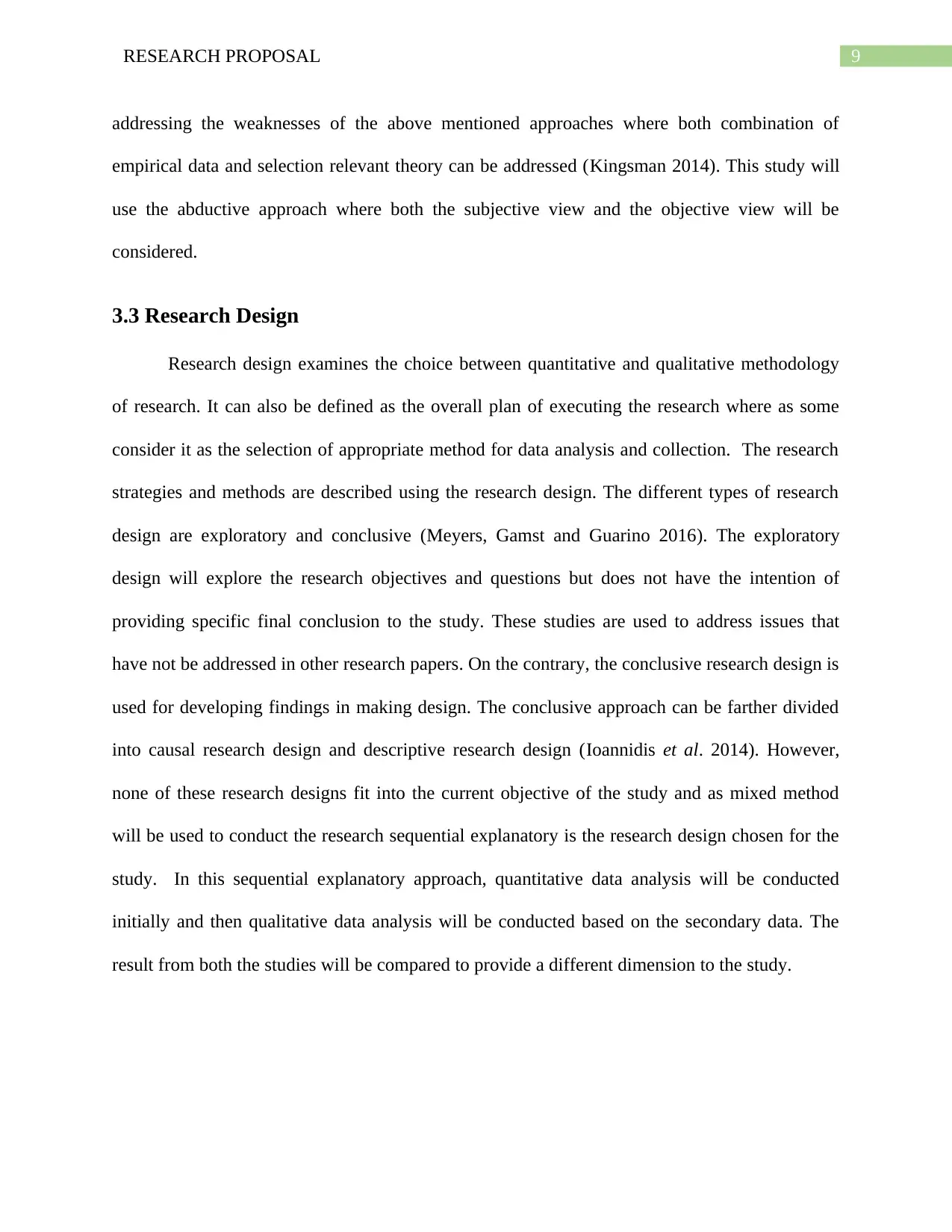
9RESEARCH PROPOSAL
addressing the weaknesses of the above mentioned approaches where both combination of
empirical data and selection relevant theory can be addressed (Kingsman 2014). This study will
use the abductive approach where both the subjective view and the objective view will be
considered.
3.3 Research Design
Research design examines the choice between quantitative and qualitative methodology
of research. It can also be defined as the overall plan of executing the research where as some
consider it as the selection of appropriate method for data analysis and collection. The research
strategies and methods are described using the research design. The different types of research
design are exploratory and conclusive (Meyers, Gamst and Guarino 2016). The exploratory
design will explore the research objectives and questions but does not have the intention of
providing specific final conclusion to the study. These studies are used to address issues that
have not be addressed in other research papers. On the contrary, the conclusive research design is
used for developing findings in making design. The conclusive approach can be farther divided
into causal research design and descriptive research design (Ioannidis et al. 2014). However,
none of these research designs fit into the current objective of the study and as mixed method
will be used to conduct the research sequential explanatory is the research design chosen for the
study. In this sequential explanatory approach, quantitative data analysis will be conducted
initially and then qualitative data analysis will be conducted based on the secondary data. The
result from both the studies will be compared to provide a different dimension to the study.
addressing the weaknesses of the above mentioned approaches where both combination of
empirical data and selection relevant theory can be addressed (Kingsman 2014). This study will
use the abductive approach where both the subjective view and the objective view will be
considered.
3.3 Research Design
Research design examines the choice between quantitative and qualitative methodology
of research. It can also be defined as the overall plan of executing the research where as some
consider it as the selection of appropriate method for data analysis and collection. The research
strategies and methods are described using the research design. The different types of research
design are exploratory and conclusive (Meyers, Gamst and Guarino 2016). The exploratory
design will explore the research objectives and questions but does not have the intention of
providing specific final conclusion to the study. These studies are used to address issues that
have not be addressed in other research papers. On the contrary, the conclusive research design is
used for developing findings in making design. The conclusive approach can be farther divided
into causal research design and descriptive research design (Ioannidis et al. 2014). However,
none of these research designs fit into the current objective of the study and as mixed method
will be used to conduct the research sequential explanatory is the research design chosen for the
study. In this sequential explanatory approach, quantitative data analysis will be conducted
initially and then qualitative data analysis will be conducted based on the secondary data. The
result from both the studies will be compared to provide a different dimension to the study.
Paraphrase This Document
Need a fresh take? Get an instant paraphrase of this document with our AI Paraphraser
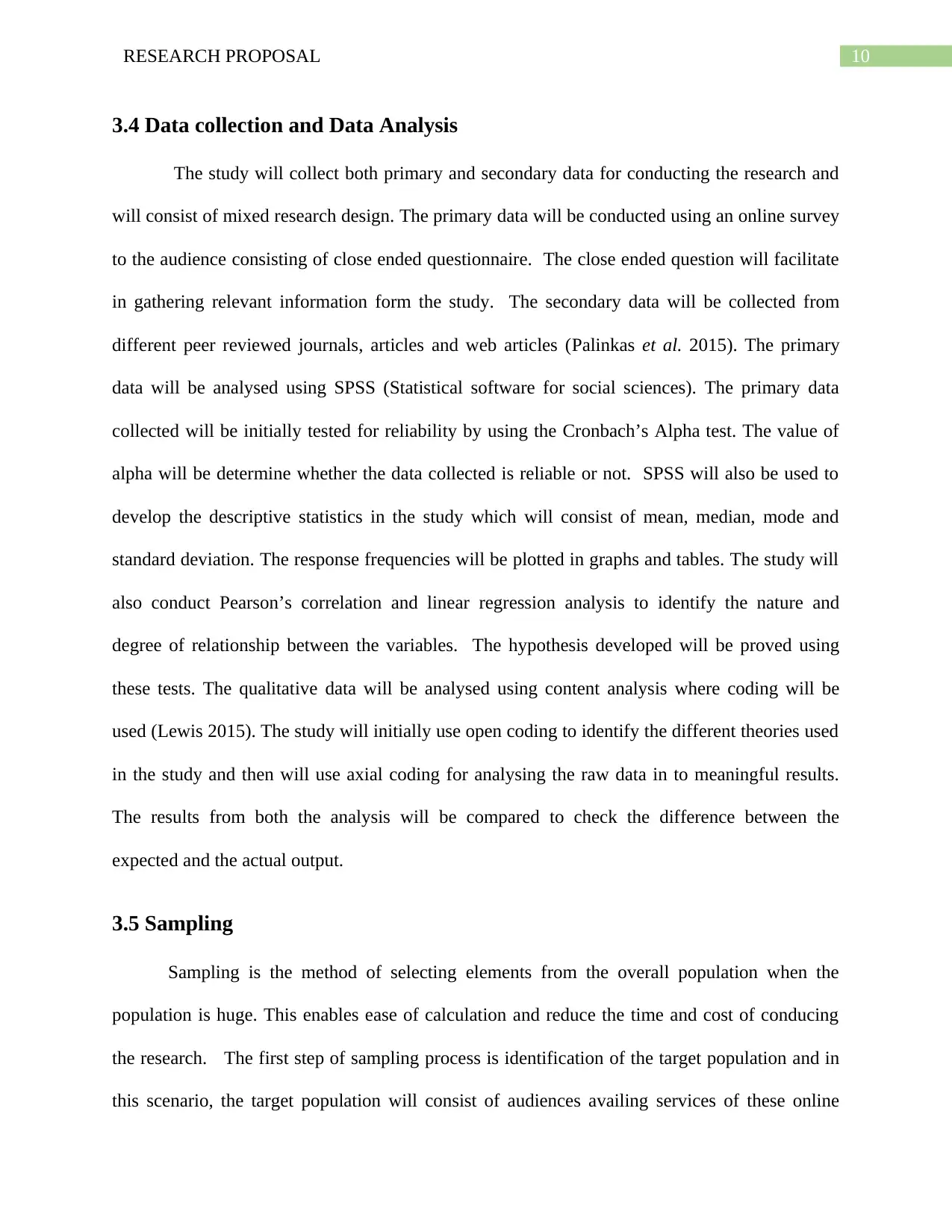
10RESEARCH PROPOSAL
3.4 Data collection and Data Analysis
The study will collect both primary and secondary data for conducting the research and
will consist of mixed research design. The primary data will be conducted using an online survey
to the audience consisting of close ended questionnaire. The close ended question will facilitate
in gathering relevant information form the study. The secondary data will be collected from
different peer reviewed journals, articles and web articles (Palinkas et al. 2015). The primary
data will be analysed using SPSS (Statistical software for social sciences). The primary data
collected will be initially tested for reliability by using the Cronbach’s Alpha test. The value of
alpha will be determine whether the data collected is reliable or not. SPSS will also be used to
develop the descriptive statistics in the study which will consist of mean, median, mode and
standard deviation. The response frequencies will be plotted in graphs and tables. The study will
also conduct Pearson’s correlation and linear regression analysis to identify the nature and
degree of relationship between the variables. The hypothesis developed will be proved using
these tests. The qualitative data will be analysed using content analysis where coding will be
used (Lewis 2015). The study will initially use open coding to identify the different theories used
in the study and then will use axial coding for analysing the raw data in to meaningful results.
The results from both the analysis will be compared to check the difference between the
expected and the actual output.
3.5 Sampling
Sampling is the method of selecting elements from the overall population when the
population is huge. This enables ease of calculation and reduce the time and cost of conducing
the research. The first step of sampling process is identification of the target population and in
this scenario, the target population will consist of audiences availing services of these online
3.4 Data collection and Data Analysis
The study will collect both primary and secondary data for conducting the research and
will consist of mixed research design. The primary data will be conducted using an online survey
to the audience consisting of close ended questionnaire. The close ended question will facilitate
in gathering relevant information form the study. The secondary data will be collected from
different peer reviewed journals, articles and web articles (Palinkas et al. 2015). The primary
data will be analysed using SPSS (Statistical software for social sciences). The primary data
collected will be initially tested for reliability by using the Cronbach’s Alpha test. The value of
alpha will be determine whether the data collected is reliable or not. SPSS will also be used to
develop the descriptive statistics in the study which will consist of mean, median, mode and
standard deviation. The response frequencies will be plotted in graphs and tables. The study will
also conduct Pearson’s correlation and linear regression analysis to identify the nature and
degree of relationship between the variables. The hypothesis developed will be proved using
these tests. The qualitative data will be analysed using content analysis where coding will be
used (Lewis 2015). The study will initially use open coding to identify the different theories used
in the study and then will use axial coding for analysing the raw data in to meaningful results.
The results from both the analysis will be compared to check the difference between the
expected and the actual output.
3.5 Sampling
Sampling is the method of selecting elements from the overall population when the
population is huge. This enables ease of calculation and reduce the time and cost of conducing
the research. The first step of sampling process is identification of the target population and in
this scenario, the target population will consist of audiences availing services of these online
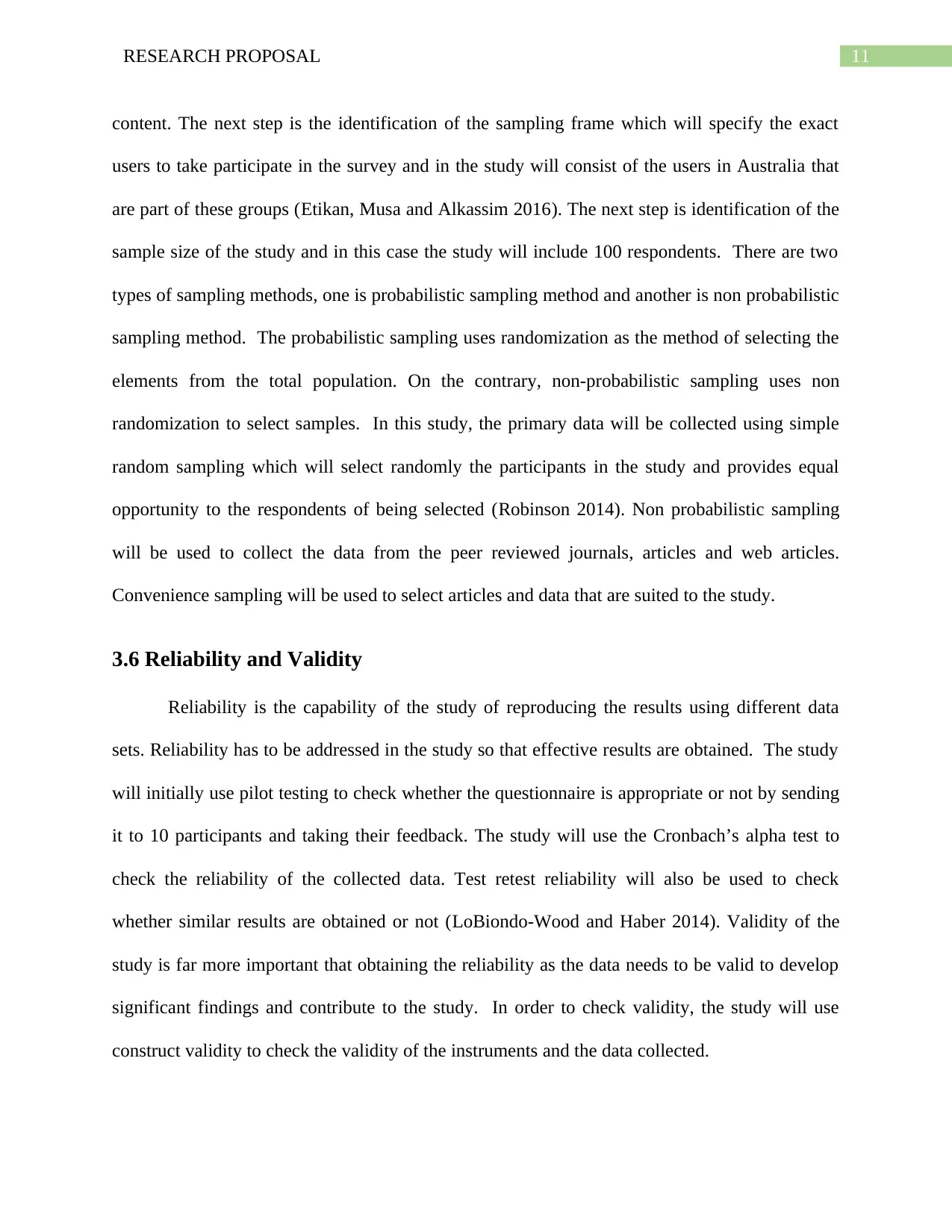
11RESEARCH PROPOSAL
content. The next step is the identification of the sampling frame which will specify the exact
users to take participate in the survey and in the study will consist of the users in Australia that
are part of these groups (Etikan, Musa and Alkassim 2016). The next step is identification of the
sample size of the study and in this case the study will include 100 respondents. There are two
types of sampling methods, one is probabilistic sampling method and another is non probabilistic
sampling method. The probabilistic sampling uses randomization as the method of selecting the
elements from the total population. On the contrary, non-probabilistic sampling uses non
randomization to select samples. In this study, the primary data will be collected using simple
random sampling which will select randomly the participants in the study and provides equal
opportunity to the respondents of being selected (Robinson 2014). Non probabilistic sampling
will be used to collect the data from the peer reviewed journals, articles and web articles.
Convenience sampling will be used to select articles and data that are suited to the study.
3.6 Reliability and Validity
Reliability is the capability of the study of reproducing the results using different data
sets. Reliability has to be addressed in the study so that effective results are obtained. The study
will initially use pilot testing to check whether the questionnaire is appropriate or not by sending
it to 10 participants and taking their feedback. The study will use the Cronbach’s alpha test to
check the reliability of the collected data. Test retest reliability will also be used to check
whether similar results are obtained or not (LoBiondo-Wood and Haber 2014). Validity of the
study is far more important that obtaining the reliability as the data needs to be valid to develop
significant findings and contribute to the study. In order to check validity, the study will use
construct validity to check the validity of the instruments and the data collected.
content. The next step is the identification of the sampling frame which will specify the exact
users to take participate in the survey and in the study will consist of the users in Australia that
are part of these groups (Etikan, Musa and Alkassim 2016). The next step is identification of the
sample size of the study and in this case the study will include 100 respondents. There are two
types of sampling methods, one is probabilistic sampling method and another is non probabilistic
sampling method. The probabilistic sampling uses randomization as the method of selecting the
elements from the total population. On the contrary, non-probabilistic sampling uses non
randomization to select samples. In this study, the primary data will be collected using simple
random sampling which will select randomly the participants in the study and provides equal
opportunity to the respondents of being selected (Robinson 2014). Non probabilistic sampling
will be used to collect the data from the peer reviewed journals, articles and web articles.
Convenience sampling will be used to select articles and data that are suited to the study.
3.6 Reliability and Validity
Reliability is the capability of the study of reproducing the results using different data
sets. Reliability has to be addressed in the study so that effective results are obtained. The study
will initially use pilot testing to check whether the questionnaire is appropriate or not by sending
it to 10 participants and taking their feedback. The study will use the Cronbach’s alpha test to
check the reliability of the collected data. Test retest reliability will also be used to check
whether similar results are obtained or not (LoBiondo-Wood and Haber 2014). Validity of the
study is far more important that obtaining the reliability as the data needs to be valid to develop
significant findings and contribute to the study. In order to check validity, the study will use
construct validity to check the validity of the instruments and the data collected.
⊘ This is a preview!⊘
Do you want full access?
Subscribe today to unlock all pages.

Trusted by 1+ million students worldwide
1 out of 18
Related Documents
Your All-in-One AI-Powered Toolkit for Academic Success.
+13062052269
info@desklib.com
Available 24*7 on WhatsApp / Email
![[object Object]](/_next/static/media/star-bottom.7253800d.svg)
Unlock your academic potential
Copyright © 2020–2025 A2Z Services. All Rights Reserved. Developed and managed by ZUCOL.




